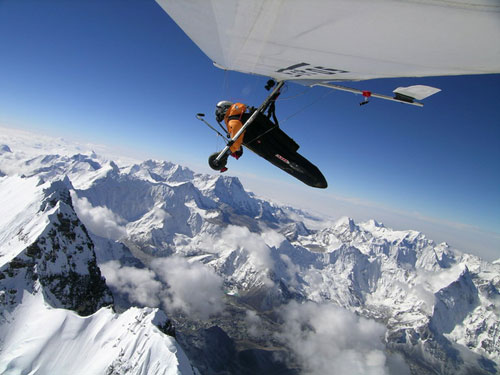-
Posts
4,281 -
Joined
-
Last visited
-
Days Won
11
Content Type
Profiles
Forums
Gallery
Downloads
Blogs
Events
Store
Aircraft
Resources
Tutorials
Articles
Classifieds
Movies
Books
Community Map
Quizzes
Posts posted by eightyknots
-
-
Fantastic video. Thanks for sharing this with the forum., Ultralights!!
-
Are there any Savannahs with 'glass panel' instruments? If so:
* are they worth it?
* are they better?
* are they lighter?
Any other thoughts on Savannah instruments in addition to the standard set supplied by the manufacturer?
-
This is the rule in New Zealand, for comparison:
when the applicant for the issue
of an Advanced Pilot Certificate is the holder of a valid
Private Pilots Licence - Aeroplane, they will only be
required to:
(i) complete a microlight type conversion and a
minimum of two hours solo; and
(ii) demonstrate to a microlight instructor his/her general
knowledge and ability to perform competently such
normal and emergency flight manoeuvres as may be
considered necessary for the issue of an Advanced
Pilot Certificate; and
(iii) have their logbook endorsed for the rating
-
Apart from the obvious (a gas planet in our solar system), in what context do you mean "a Saturn"?
-
-
I am wondering about the instruments used in Savannah planes. It appears that the kit has this well and truly prescribed, unlike other planes that I am comparing this with which allows a lot of lattitude for personalising. For instance the icp website says that standard instruments are:
Anemometer D. 3 1/8” with coloured arcs
Altimeter D. 3 1/8” with setting window
Variometer D. 3 1/8”
Compass
Sljp and skid indicator
Tachometer
Fuel pressure
Oil pressure
Oil temperature
Hourmeter
Voltmeter
External temperature indicator + airbox (for Rotax 912 ULS only)
Water temperature in front left engine head
Water temperature in back right engine head
Could someone tell me whether the instrument panel allows for any additional instrument options (pictures seem to suggest that the standard instruments are pretty widely spaced).
Alternatively, has anyone set up an instrument panel quite different from the standard icp configuration?
-
Hang gliders and paragliding aircraft look pretty light to me.Hang gliders are ultralights now??However, they don't fall into the now-accepted definition of 'ultralight'.
Why then, is it possible for an IFR aircraft to nearly run into them just below 7,000 feet without having this matter sorted/addressed in some way?
-
Thanks for that tip BlackRod, it was really easy to read that way.
It is similarly a concern that there also six Continental engine failures in addition to the eight Jabs listed.
-
It's a shame that Jabiru uses steel for their cylinders. They could lighten the whole engine by using aluminium for the cylinders and possibly employ stainless steel liners.Hi Ozzie,Don't get your statement about high pressure injected moulded heads and cylinder? The cylinder are machined out of a slingle billet of steel.. what wrong with that?Cheers
Jack
-
The writing is...
...just a bit too small to read comfortably

-
There have been a number of injuries, the worst was caused by a falling brick chimney. So far, there are no reports of fatalities. We better pray for the people of Christchurch in their predicament! It won't be much fun in the next few weeks and months as the city has to be rebuilt.
-
A dipstick -if used correctly- is one of the two most foolproof systems far better than gauges (although impossible to use in-flight).Might sound simple, but you can't go wrong with a bit of dip stick - in most cases.The other is the use of a sight glass in the cabin, as used in some high wing planes. This is very useful in-flight as well.
-
As long as there is very good quality control (perhaps x-ray diagnostics) that there are no little air bubbles in the injected metal.I'll make one suggestion that WILL make an improvement on reliability and that is high pressure injection moulding for the heads and cyls. -
This is somewhat strange. The whole idea of the ultralight movement was that aviators would not need to conform to all the GA restrictions: that it would simply be low cost recreational flying with much lower technical complexity requirements. This was meant to include electronic communications.the hang gliders and para gliders on CB radiosNow we learn that they use two way radio communications after all!
-
Where is the electric replacement for the Rotax 912S?
-
When flying inland in summer with lots of "bumps" it can be better to fly higher than 5000ft. I for one admit to doing that when this practice will result in a smoother flight. When doing it though keep in mind flying at correct altitudes and broadcasting your track on the relevant area frequency. Most of the time though I keep well below tha 5000ft limit as I believe most/all of us do as flying high is not as much fun anyway.
fly safe
Walter
My presumption is that Walter has only admitted going to around 5,001 feet. Nowhere do I see him explicitly admitting to any more than that!Hey guys with the attitude of 'professional prosecutors' i'd be wary of admitting anything online. might attract yourself some problems. -
Yenn, you say: "Life's a golf ball. Full of depressions."
What about looking at it another way? i.e., Life's like a golf ball. Full of little high points.
-
That's such a cool set of photos: what a majestic flight that would have been!
I'm interested in the effectiveness of the cabin heater too: what kind of heater do you have?
-
It's really great to see someone still active, in their nineties, building a plane :-)I have had the great privilege of knowing David Archer for the last few years . He has an infectious personality ,a great sense of humour and wit . There is an article in the local Macarthur newspaper this week detailing Davids efforts . Here is a link to the article , and please check out the video too .Dave C
-
They're really neat rudder pedals. Probably more life-like than the fantastic plastic simulator pedals on the market for hundreds of dollars!
-
Has anyone ever done any kind of analysis of the ratio of Jabiru engine failures compared to other (e.g. Rotax) engines?
It would really help prospective plane builders make up their minds with respect to a power plant for their bird.
Just as well this embarrassed pilot wasn't over Bass Strait just at the halfway point between Victoria and Tasmania :-)
-
...yes, except the weight and power.No question which way the graphs are headed. Avgas/ULP going up and electricity/batteries down. It is only a question of time.I don't think a Rotax 912 engine & full fuel tanks will be replaced by an electric motor & batteries of similar power and/or endurance for at least a decade.
-
I couldn't access this via my Yahoo sign-in (I'm a member of the Savannah group). Were there any picture attachments?
-
Dedication Personified
There is some great flying in those clips.
Those MAF aviators are not only very skilled, they are also very dedicated to helping out their fellow man.
May their good work long continue!




Instruments options in Savannah aircraft
in Savannah
Posted
That looks interesting: is there a New Zealand dealer for this, Spectre?